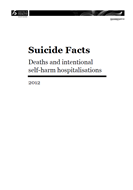This annual statistical publication presents suicide information received from the New Zealand Mortality Collection, and admissions to hospital for intentional self-harm sourced from the New Zealand National Minimum Dataset.
Published online:
07 May 2015

Key findings
Overview
- A total of 549 people died by suicide in New Zealand in 2012. Almost 75% of these suicides were male.
- The age-standardised suicide rate decreased by 19.5% from the peak rate of 15.1 deaths per 100,000 population in 1998 to 12.2 deaths per 100,000 population in 2012.
Sex
- There were 404 male suicides (18.1 per 100,000 males) and 145 female suicides (6.4 per 100,000 females) in 2012.
- For every female suicide, there were 2.8 male suicides.
- Since 1948, the suicide rate for females has remained relatively stable. The male suicide rate for 2012 was 24.3% lower than its highest rate in 1995.
Age
- The highest rate of suicide in 2012 was in the youth age group (15–24 years) at 23.4 per 100,000 youths.
- Suicide rates decreased with age: the suicide rate for adults aged 25–44 years was 15.8 per 100,000 adults in that age group; the rate decreased to 12.9 per 100,000 adults aged 45–64 years.
- Adults aged 65 years and over had the lowest suicide rate (9.3 per 100,000 adults aged 65+ years).
Youth (15–24 years)
- In 2012, there were 107 male and 43 female youth suicides (32.3 and 13.8 per 100,000 males and females respectively).
- The Māori youth suicide rate was 2.8 times the non-Māori youth rate (48.0 per 100,000 Māori youths compared with 17.3 per 100,000 non-Māori youths).
- Over the 10 years from 2003 to 2012, Māori youth suicide rates have been at least 1.7 times the non-Māori youth suicide rates.
Ethnicity
- There were 120 Māori and 429 non-Māori suicide deaths in 2012.
- Māori had an age-standardised suicide rate of 17.8 per 100,000 Māori, compared with the non-Māori rate of 10.6 per 100,000 non-Māori.
- There were 30 suicide deaths among Pacific people and 23 among Asian people.
- Over the 10 years from 2003 to 2012, Māori suicide rates have been at least 1.2 times non-Māori suicide rates.
Deprivation
- In 2012, the suicide rate was highest among those who resided in deprivation quintile 4 and lowest in quintile 1 (14.0 per 100,000 quintile 4 population compared with 6.6 per 100,000 quintile 1 population).
- Suicide rates in both quintile 1 and 2 were significantly lower than suicide rates for those residing in quintiles 3–5.
Urban/rural profile
- The suicide rate was 14.6 per 100,000 population in rural areas and 12.0 per 100,000 population in urban areas.
District health board (DHB) region
- Based on aggregated data for the five-year period 2008–2012, Bay of Plenty, South Canterbury and Southern DHBs had significantly higher suicide rates than the national rate.
- Waitemata, Auckland and Capital & Coast DHB regions had significantly lower suicide rates than the national rate.
Intentional self-harm hospitalisations
Overview
- There were 3031 intentional self-harm hospitalisations in New Zealand in 2012. Two-thirds of these were female.
- Over the 10-year period 2003–2012, the rate of self-harm hospitalisations decreased by 11.5% from 80.3 per 100,000 population in 2003 to 71.0 per 100,000 population in 2012.
Sex
- In 2012, the female rate of intentional self-harm hospitalisation was more than twice the male rate (96.1 per 100,000 females compared with 46.4 per 100,000 males).
- Between 2003 and 2012, the female rate of intentional self-harm hospitalisation remained at least 1.7 times the male rate.
Age
- In 2012, the highest rate of intentional self-harm hospitalisations for both males and females was in the 15–19 years age group (103.1 per 100,000 15–19 years males and 279.5 per 100,000 15–19 years females).
- Female rates were significantly higher than male rates for all five-year age groups except in those aged 75+ years, where they were significantly lower.
Youth (15–24 years)
- Youth accounted for 34.7% (1052) of all intentional self-harm hospitalisations in 2012.
- The female rate of intentional self-harm hospitalisations was 2.4 times the male rate (233.7 per 100,000 females and 98.4 per 100,000 males).
Ethnicity
- In 2012, Māori accounted for nearly 20% (563) of all intentional self-harm hospitalisations.
- The age-standardised rate for Māori was 85.0 per 100,000 Māori compared with 68.0 per 100,000 non-Māori.
- There were 101 intentional self-harm hospitalisations of Pacific people and 97 of Asian people.
Deprivation
- In 2012, intentional self-harm hospitalisation rates generally increased with deprivation; the highest rate was in those residing in deprivation quintile 4 and the lowest in quintile 1 (90.9 per 100,000 quintile 4 population compared with 49.6 per 100,000 quintile 1 population).
- For both males and females, rates in the least deprived quintile (1) were significantly lower than rates in more deprived quintiles (3–5).
District health board (DHB) region
- Based on aggregated data from 2010–2012, eight DHBS had significantly higher rates of intentional self-harm hospitalisations than the national rate in 2012. Wairarapa DHB region had the highest age-standardised rate of intentional self-harm hospitalisations (169.0 per 100,000 population).
- Auckland, Counties Manukau, Hawke’s Bay and MidCentral DHB regions had significantly lower rates of intentional self-harm hospitalisations than the national rate.
